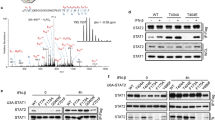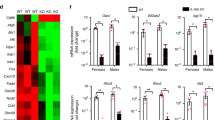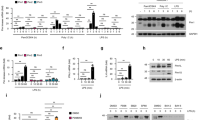Abstract
We report here the identification of a ligand-receptor system that, upon engagement, leads to the establishment of an antiviral state. Three closely positioned genes on human chromosome 19 encode distinct but paralogous proteins, which we designate interferon-λ1 (IFN-λ1), IFN-λ2 and IFN-λ3 (tentatively designated as IL-29, IL-28A and IL-28B, respectively, by HUGO). The expression of IFN-λ mRNAs was inducible by viral infection in several cell lines. We identified a distinct receptor complex that is utilized by all three IFN-λ proteins for signaling and is composed of two subunits, a receptor designated CRF2-12 (also designated as IFN-λR1) and a second subunit, CRF2-4 (also known as IL-10R2). Both receptor chains are constitutively expressed on a wide variety of human cell lines and tissues and signal through the Jak-STAT (Janus kinases–signal transducers and activators of transcription) pathway. This receptor-ligand system may contribute to antiviral or other defenses by a mechanism similar to, but independent of, type I IFNs.
This is a preview of subscription content, access via your institution
Access options
Subscribe to this journal
Receive 12 print issues and online access
$209.00 per year
only $17.42 per issue
Buy this article
- Purchase on Springer Link
- Instant access to full article PDF
Prices may be subject to local taxes which are calculated during checkout








Similar content being viewed by others
References
Kotenko, S.V. The family of IL10-related cytokines and their receptors: related, but to what extent? Cytokine Growth Factor Rev. 13, 223–240 (2002).
Kotenko, S.V. & Pestka, S. Jak-Stat signal transduction pathway through the eyes of cytokine class II receptor complexes. Oncogene 19, 2557–2565 (2000).
Dumoutier, L. & Renauld, J.C. Viral and cellular interleukin-10 (IL-10)-related cytokines: from structures to functions. Eur. Cytokine Netw. 13, 5–15 (2002).
Fickenscher, H. et al. The interleukin-10 family of cytokines. Trends Immunol. 23, 89–96 (2002).
Pestka, S. The human interferon α species and hybrid proteins. Semin. Oncol. 24 (Suppl. 9) 4–17 (1997).
LaFleur, D.W. et al. Interferon-κ, a novel type I interferon expressed in human keratinocytes. J. Biol. Chem. 276, 39765–39771 (2001).
Conklin, D.C., Grant, F.J., Rixon, M.W. & Kindsvogel, W. Interferon-ε. U.S. Patent 6329175 (2002).
Moore, K.W., de Waal, M.R., Coffman, R.L. & O'Garra, A. Interleukin-10 and the interleukin-10 receptor. Annu. Rev. Immunol. 19, 683–765 (2001).
Levy, D.E. & Garcia-Sastre, A. The virus battles: IFN induction of the antiviral state and mechanisms of viral evasion. Cytokine Growth Factor Rev. 12, 143–156 (2001).
Samuel, C.E. Antiviral actions of interferons. Clin. Microbiol. Rev. 14, 778–809 (2001).
Biron, C.A. Interferons α and β as immune regulators–a new look. Immunity 14, 661–664 (2001).
Le Bon, A. & Tough, D.F. Links between innate and adaptive immunity via type I interferon. Curr. Opin. Immunol. 14, 432–436 (2002).
Prejean, C. & Colamonici, O.R. Role of the cytoplasmic domains of the type I interferon receptor subunits in signaling. Semin. Cancer. Biol. 10, 83–92 (2000).
Domanski, P. & Colamonici, O.R. The type-I interferon receptor. The long and short of it. Cytokine Growth Factor Rev. 7, 143–151 (1996).
Darnell, J.E. Jr., Kerr, I.M. & Stark, G.R. Jak-STAT pathways and transcriptional activation in response to IFNs and other extracellular signaling proteins. Science 264, 1415–1421 (1994).
Steinhoff, U. et al. Antiviral protection by vesicular stomatitis virus-specific antibodies in α/β interferon receptor-deficient mice. J. Virol. 69, 2153–2158 (1995).
Muller, U. et al. Functional role of type I and type II interferons in antiviral defense. Science 264, 1918–1921 (1994).
Hwang, S.Y. et al. A null mutation in the gene encoding a type I interferon receptor component eliminates antiproliferative and antiviral responses to interferons α and β and alters macrophage responses. Proc. Natl. Acad. Sci. USA 92, 11284–11288 (1995).
Lu, B. et al. Targeted disruption of the interferon-γ receptor 2 gene results in severe immune defects in mice. Proc. Natl. Acad. Sci. USA 95, 8233–8238 (1998).
Angel, J., Franco, M.A., Greenberg, H.B. & Bass, D. Lack of a role for type I and type II interferons in the resolution of rotavirus-induced diarrhea and infection in mice. J. Interferon Cytokine Res. 19, 655–659 (1999).
Kotenko, S.V. et al. Identification and functional characterization of a second chain of the interleukin-10 receptor complex. EMBO J. 16, 5894–5903 (1997).
Wolk, K., Kunz, S., Asadullah, K. & Sabat, R. Cutting edge: immune cells as sources and targets of the IL-10 family members? J. Immunol. 168, 5397–5402 (2002).
Blumberg, H. et al. Interleukin 20: discovery, receptor identification, and role in epidermal function. Cell 104, 9–19 (2001).
Kotenko, S.V. et al. Other kinases can substitute for Jak2 in signal transduction by interferon-γ. J. Biol. Chem. 271, 17174–17182 (1996).
Kotenko, S.V. et al. Identification of the functional interleukin-22 (IL-22) receptor complex: the IL-10R2 chain (IL-10Rβ) is a common chain of both the IL-10 and IL-22 (IL-10-related T cell-derived inducible factor, IL-TIF) receptor complexes. J. Biol. Chem. 276, 2725–2732 (2001).
Siegal, F.P. et al. The nature of the principal type 1 interferon-producing cells in human blood. Science 284, 1835–1837 (1999).
Knappe, A., Hor, S., Wittmann, S. & Fickenscher, H. Induction of a novel cellular homolog of interleukin-10, AK155, by transformation of T lymphocytes with herpesvirus saimiri. J. Virol. 74, 3881–3887 (2000).
Levy, D.E. . Whence interferon? Variety in the production of interferon in response to viral infection. J. Exp. Med. 195, 15–18 (2002).
Kotenko, S.V., Izotova, L.S., Mirochnitchenko, O.V., Lee, C. & Pestka, S. The intracellular domain of interferon-receptor 2c (IFN-R2c) chain is responsible for Stat activation. Proc. Natl. Acad. Sci. USA 96, 5007–5012 (1999).
Nadeau, O.W. et al. The proximal tyrosines of the cytoplasmic domain of the β chain of the type I interferon receptor are essential for signal transducer and activator of transcription (Stat) 2 activation. Evidence that two Stat2 sites are required to reach a threshold of interferon α-induced Stat2 tyrosine phosphorylation that allows normal formation of interferon-stimulated gene factor 3. J. Biol. Chem. 274, 4045–4052 (1999).
Wagner, T.C. et al. Interferon signaling is dependent on specific tyrosines located within the intracellular domain of IFNAR2c. Expression of IFNAR2c tyrosine mutants in U5A cells. J. Biol. Chem. 277, 1493–1499 (2002).
Goldman, L.A., Cutrone, E.C., Kotenko, S.V., Krause, C.D. & Langer, J.A. Modifications of vectors pEF-BOS, pcDNA1 and pcDNA3 result in improved convenience and expression. Biotechniques 21, 1013–1015 (1996).
Kotenko, S.V., Saccani, S., Izotova, L.S., Mirochnitchenko, O.V. & Pestka, S. Human cytomegalovirus harbors its own unique IL-10 homolog (cmvIL-10). Proc. Natl. Acad. Sci. USA 97, 1695–1700 (2000).
Li, B.L., Langer, J.A., Schwartz, B. & Pestka, S. Creation of phosphorylation sites in proteins: construction of a phosphorylatable human interferon α. Proc. Natl. Acad. Sci. USA 86, 558–562 (1989).
Soh, J. et al. Identification of a yeast artificial chromosome clone encoding an accessory factor for the human interferon γ receptor: evidence for multiple accessory factors. Proc. Natl. Acad. Sci. USA 90, 8737–8741 (1993).
Barnstable, C.J. et al. Production of monoclonal antibodies to group A erythrocytes, HLA and other human cell surface antigens-new tools for genetic analysis. Cell 14, 9–20 (1978).
Kotenko, S.V. et al. Interaction between the components of the interferon γ receptor complex. J. Biol. Chem. 270, 20915–20921 (1995).
Reich, N. et al. Interferon-induced transcription of a gene encoding a 15-kDa protein depends on an upstream enhancer element. Proc. Natl. Acad. Sci. USA 84, 6394–6398 (1987).
Gallagher, G. et al. Cloning, expression and initial characterization of interleukin-19 (IL- 19), a novel homologue of human interleukin-10 (IL-10). Genes Immun. 1, 442–450 (2000).
Pestka, S. et al. Introduction of protein kinase recognition sites into proteins: a review of their preparation, advantages, and applications. Protein Expr. Purif. 17, 203–214 (1999).
Kotenko, S.V. et al. Identification, cloning, and characterization of a novel soluble receptor that binds IL-22 and neutralizes its activity. J. Immunol. 166, 7096–7103 (2001).
Yu, S.H. et al. Intrahepatic mRNA expression of interferon-inducible antiviral genes in liver diseases: dsRNA-dependent protein kinase overexpression and RNase L inhibitor suppression in chronic hepatitis C. Hepatology 32, 1089–1095 (2000).
Tian, Z., Shen, X., Feng, H. & Gao, B. IL-1 β attenuates IFN-α β-induced antiviral activity and STAT1 activation in the liver: involvement of proteasome-dependent pathway. J. Immunol. 165, 3959–3965 (2000).
Familletti, P.C., Rubinstein, S. & Pestka, S. A convenient and rapid cytopathic effect inhibition assay for interferon. Meth. Enzymol. 78, 387–394 (1981).
Acknowledgements
Supported in part by United States Public Health Services grant RO1 AI51139 from the National Institute of Allergy and Infectious Diseases and by American Heart Association grant AHA number 0245131N (to S.V.K) and by startup funds from the Department of Oral Biology, NJDS (to G.G.). We are thankful to S. Pestka for providing 16-9 hamster cells and other valuable reagents, and P. Liang for HaCaT cells.
Author information
Authors and Affiliations
Corresponding authors
Ethics declarations
Competing interests
The authors declare no competing financial interests.
Rights and permissions
About this article
Cite this article
Kotenko, S., Gallagher, G., Baurin, V. et al. IFN-λs mediate antiviral protection through a distinct class II cytokine receptor complex. Nat Immunol 4, 69–77 (2003). https://doi.org/10.1038/ni875
Received:
Accepted:
Published:
Issue Date:
DOI: https://doi.org/10.1038/ni875
This article is cited by
-
The population context is a driver of the heterogeneous response of epithelial cells to interferons
Molecular Systems Biology (2024)
-
Portraying the dark side of endogenous IFN-λ for promoting cancer progression and immunoevasion in pan-cancer
Journal of Translational Medicine (2023)
-
Interleukin-22 facilitates the interferon-λ-mediated production of tripartite motif protein 25 to inhibit replication of duck viral hepatitis A virus type 1
Veterinary Research (2023)
-
Occludin: a gatekeeper of brain Infection by HIV-1
Fluids and Barriers of the CNS (2023)
-
The Influenza-Induced Pulmonary Inflammatory Exudate in Susceptible Tpl2-Deficient Mice Is Dictated by Type I IFN Signaling
Inflammation (2023)



